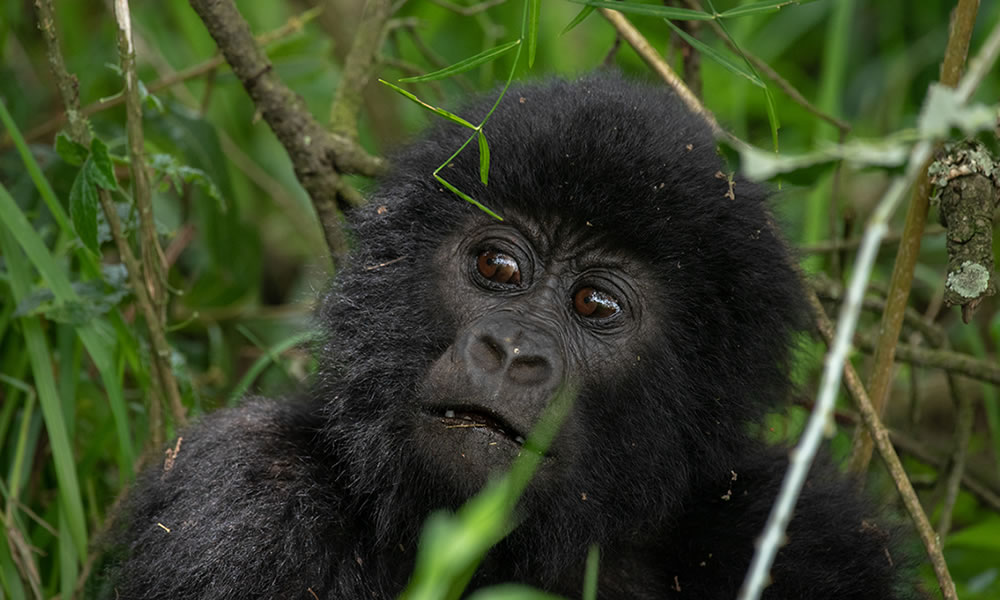Bwindi Impenetrable National Park is located in southwest Uganda, on the edge of the Rift Valley. Its mist-covered mountains are covered with one of Uganda’s oldest and most biologically diverse rain forests, which dates back over 25,000 years and is home to some 400 plant species. This “impenetrable forest” is better renowned for housing an estimated 459 mountain gorillas, or over half of the species’ total population. A number of these ingrained cohorts could be monitored.

Situated in the southwest of Uganda, Bwindi Impenetrable Forest National Park is a popular safari destination due to its dense foliage, as suggested by its name. Every day as tourists embark on the well-known gorilla trekking experience, ranger guides must clear undergrowth to allow trackers to reach the gorillas’ previous night’s nesting location. It is a true African rainforest, with rays of sunlight filtering through the dense forest cover, creating the illusion that you are in paradise and free of the various emissions that characterise our everyday surroundings.
A further 120 mammals, including many primate species like baboons and chimpanzees, as well as elephants and antelopes, find refuge in this biologically varied area. This forest is home to about 350 different kinds of birds, 23 of which are endemic to the Albertine Rift.
Eight indigenous species of the Albaertine Rift are among the 200+ butterfly species that call Bwindi home. A haven for several reptiles. The adjacent villages of Buhoma and Nkuringo provide an equally excellent selection of dining options, craft shops, guiding services, and accommodations ranging from opulent lodges to affordable bandas and campsites. There are many opportunities to learn about the Bakiga and Batwa Pygmy cultures in the area through village walks, workshops, and performances.
Things to do in Bwindi Impenetrable National Park.
Gorilla Tracking.
Half of the mountain gorilla population still living today is found in Bwindi. After obtaining a gorilla-tracking permission from the Uganda Wildlife Authority, gorilla tracking is carried out every day. To guarantee your day, it is recommended that you reserve your permit at least three months in advance, particularly if you have a preferred site. Every day, only eight individuals who are at least 15 years old are allowed to see a gorilla family. You will not be able to track if you are not in excellent health because infections can spread quickly between people and gorillas. Before going on a tracking expedition, your guide will brief you and give you safety tips, such as keeping a minimum distance of 8 metres from the gorillas, avoiding flash photography, and avoiding staring into their eyes for prolonged periods of time. Wear long sleeves and blouses to protect your skin from scratches while you hike through the forest. You should also pack plenty of water, seasoned footwear, a rain poncho, lunch (since it can take a whole day to find them), and, due of the challenging terrain, you might want to consider hiring a potter.
Bird Watching.
Approximately 350 different species of birds can be found in the Bwindi Impenetrable Forest National Park. Because of its distinctive bird species, it is by far the greatest location in Uganda for birdwatching. There are 23 Albertine Rift endemic species in the forest, 14 of which are unique to Uganda. Among the endangered species worldwide are the Shelley’s Crimson-wing, Chapin’s Flycatcher, and Grauer’s broadbill. Additional species include Fraser’s Eagle, Black-billed Turaco, Mountain-masked and Collared Apalis, Handsome Francolin, Purple-breasted, Blue-headed, and Regal Sunbirds, among others. The Mubwindi Swamp in the Ruhija sector of the park, “The Neck,” a section of forest connecting Ruhija to the Buhoma sector, and the Buhoma area, particularly along the waterfall route, are the principal locations for birdwatching in Bwindi.
Guided Nature Walks.
For whatever interest you may have, there are multiple pathways leading into the forest. There are trails that take you to stunning waterfalls where you may take a plunge in the water. In addition to serving as a guide, an armed Uganda wildlife ranger protects you in case you come across a wild animal. Among the treks is the Buhoma-Nkuringo track, which traverses the national park in 4–5 hours. Walk up Rushura Hill a path that winds through a forest that is shared by Uganda and Congo. Walk the 14 km Muyanga Waterfall Walk and Ivi River Walk in around 7 hours. Muzubijiro Loop: a 6-kilometer stroll around the hill that offers the opportunity to see and interact with primates and birds.
Mountain Hiking.
The steep Kigezi region, home of the Bwindi Impenetrable Forest, boasts breathtaking beauty. If you ask them for a project you can rent from, most resorts have bikes you can rent for the day to ride the unique paths made in the area. Ivi River Trail: “Ride for a Woman” organises a trail that runs from Buhoma Park Headquarters to the Ivi River.
Cultural Experiences.
There are plenty of things to do and places to see in the local culture in the area surrounding Bwindi Forest. You have the option to live as a Batwa, a people who spent a long time living in the forest. Here, you will have the opportunity to revisit the forest with them and learn about their way of life—living in harmony with the gorillas and other wildlife for many years. A forest reserve next to Bwindi Impenetrable National Park, Nkuringo, is home to the Buniga Forest Nature Walk. The King Bakyara Waterfall Trail and the Nyundo Community Ecotrail. Take a tour of Conservation through Public Health’s (CTPH) aquaponics project in the community. Discover how bananas are used to make juice, beer, gin, and flavour on the Buhoma community tours, which also include stops at points of interest, handcraft stores, the Batwa village, traditional healers, and elementary schools.
Best Time to Visit
Although Bwindi Impenetrable National Park is open to visitors all year round, the dry seasons, December through February and June through September, are the ideal times to go. Anticipate bright sky, perfect trekking weather, and stunning views of the mountains. Because trails are less slick, they are easier to navigate. These dry months are also great for a conventional wildlife safari extension, since animals are more likely to be spotted as they search for water sources.
The wet seasons (March to May and October to November) have an ethereal allure, though, if you’re looking for more tranquilly and beautiful surroundings. Vibrant greens emerge from the woodland, and a layer of mist changes the scenery. Less crowds translate into a more personal gorilla experience. Just remember to bring rain gear and be ready for maybe softer terrain.
